BlackCat (aka AlphaVM, AlphaV) is a newly established RaaS (Ransomware as a Service) with payloads written in Rust. While BlackCat is not the first ransomware written in the Rust language, it joins a small (yet growing) sliver of the malware landscape making use of this popular cross-platform language.
First appearing in late November, BlackCat has reportedly been attacking targets in multiple countries, including Australia, India and the U.S, and demanding ransoms in the region of $400,000 to $3,000,000 in Bitcoin or Monero.
BlackCat Ransomware Overview
In order to attract affiliates, the authors behind BlackCat have been heavily marketing their services in well-known underground forums.
BlackCat operators maintain a victim blog as is standard these days. The blog hosts company names and any data leaked in the event that the victims do not agree to cooperate.
Current data indicates primary delivery of BlackCat is via 3rd party framework/toolset (e.g., Cobalt Strike) or via exposed (and vulnerable) applications. BlackCat currently supports both Windows and Linux operating systems.
BlackCat Configuration Options
Samples analyzed (to date ) require an “access token” to be supplied as a parameter upon execution. This is similar to threats like Egregor, and is often used as an anti-analysis tactic. This ‘feature’ exists in both the Windows and Linux versions of BlackCat.
However, the BlackCat samples we analyzed could be launched with any string supplied as the access token. For example:
Malware.exe -v --access-token 12345
The ransomware supports a visible command set, which can be obtained via the -h or --help parameters.
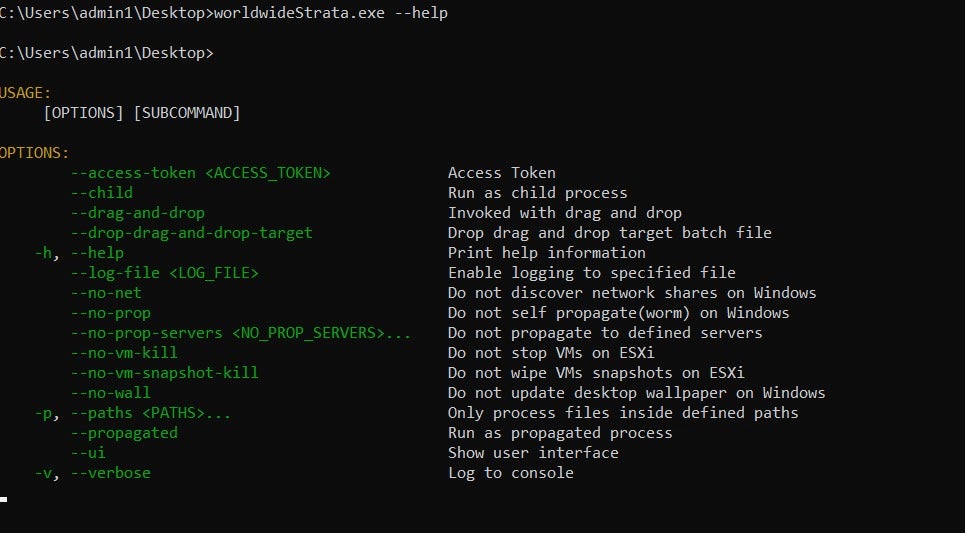
As seen above, the executable payloads support a variety of commands, many of which are VMware-centric.
--no-prop Do not self propagate(worm) on Windows --no-prop-servers <NO_PROP_SERVERS> Do not propagate to defined servers --no-vm-kill Do not stop VMs on ESXi --no-vm-snapshot-kill Do not wipe VMs snapshots on ESXi --no-wall Do not update desktop wallpaper on Windows
In verbose mode (-v) the following output can be observed upon launch of the BlackCat payloads:
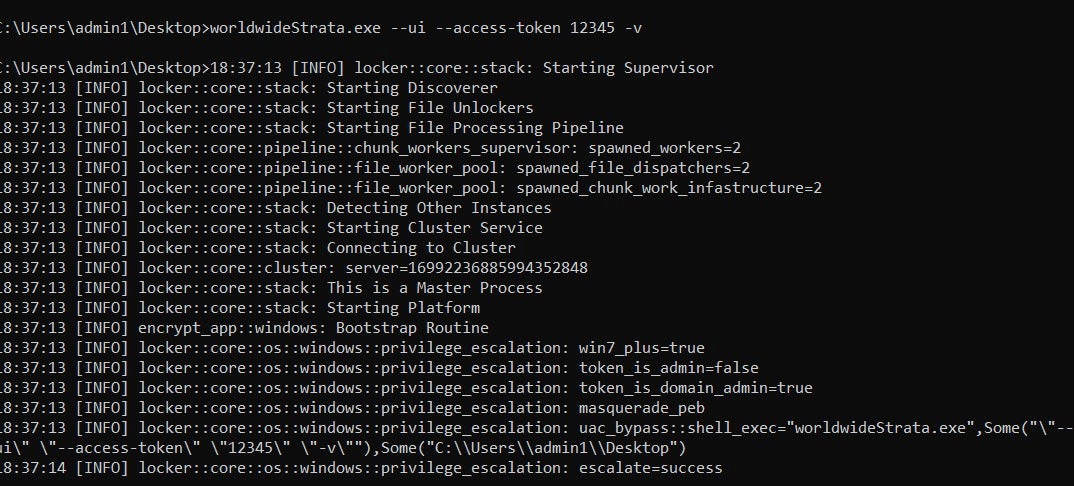
BlackCat Execution and Encryption Behaviour
Immediately upon launch, the malware will attempt to validate the existence of the previously mentioned access-token, followed by querying for the system UUID (wmic).
Those pieces of data are concatenated together into what becomes the ‘Access key’ portion of their recovery URL displayed in the ransom note. In addition, on Windows devices, BlackCat attempts to delete VSS (Volume Shadow Copies) as well as enumerate any accessible drives to search for and encrypt eligible files.
Other configuration parameters are evaluated before proceeding to execute multiple privilege escalation methods, based on the OS identified by wmic earlier. These methods are visible at the time of execution and include the use of the Com Elevation Moniker.
It is at this point that BlackCat will attempt to terminate any processes or services listed within the configuration such as any processes which may inhibit the encryption process. There are also specific files and directories that are excluded from encryption. Much of this is configurable at the time of building the ransomware payloads.
The targeted processes and services are noted in the kill_processes and kill_services sections respectively. File and folder exclusions are handled in the exclude directory_names section.
To further illustrate, the following were extracted from sample d65a131fb2bd6d80d69fe7415dc1d1fd89290394/74464797c5d2df81db2e06f86497b2127fda6766956f1b67b0dcea9570d8b683:
Kill_Processes
| backup | memtas | mepocs | msexchange |
| sql | svc$ | veeam | vss |
Kill_Services
| agntsvc | dbeng50 | dbsnmp | encsvc |
| excel | firefox | infopath | isqlplussvc |
| msaccess | mspub | mydesktopqos | mydesktopservice |
| notepad | ocautoupds | ocomm | ocssd |
| onenote | oracle | outlook | powerpnt |
| sqbcoreservice | sql | steam | synctime |
| tbirdconfig | thebat | thunderbird | visio |
| winword | wordpad | xfssvccon |
Exclude_Directory_Names
| $recycle.bin | $windows.~bt | $windows.~ws | 386 |
| adv | all users | ani | appdata |
| application data | autorun.inf | bat | bin |
| boot | boot.ini | bootfont.bin | bootsect.bak |
| cab | cmd | com | config.msi |
| cpl | cur | default | deskthemepack |
| diagcab | diagcfg | diagpkg | dll |
| drv | exclude_file_extensions:[themepack | exclude_file_names:[desktop.ini | exe |
| hlp | hta | icl | |
| icns | ico | iconcache.db | ics |
| idx | intel | key | ldf |
| lnk | lock | mod | mozilla |
| mpa | msc | msi | msocache |
| msp | msstyles | msu] | nls |
| nomedia | ntldr | ntuser.dat | ntuser.dat.log] |
| ntuser.ini | ocx | pdb | perflogs |
| prf | program files | program files (x86) | programdata |
| ps1 | public | rom | rtp |
| scr | shs | spl | sys |
| system volume information | theme | thumbs.db | tor browser |
| windows | windows.old] | wpx |
BlackCat also spawns a number of its own processes, with syntax (for Windows) as follows:
WMIC.exe (CLI interpreter) csproduct get UUID cmd.exe (CLI interpreter) /c "reg add HKEY_LOCAL_MACHINE\SYSTEM\CurrentControlSet\Services\LanmanServer\Parameters /v MaxMpxCt /d 65535 /t REG_DWORD /f" cmd.exe (CLI interpreter) /c "wmic csproduct get UUID" cmd.exe (fsutil.exe) /c "fsutil behavior set SymlinkEvaluation R2L:1" fsutil.exe behavior set SymlinkEvaluation R2L:1 cmd.exe (fsutil.exe) /c "fsutil behavior set SymlinkEvaluation R2R:1"
The fsutil-based modifications are meant to allow for use of both remote and local symlinks. BlackCat enables ‘remote to local’ and ‘remote to remote’ capability.
fsutil.exe behavior set SymlinkEvaluation R2R:1 cmd.exe (vssadmin.exe) /c "vssadmin.exe delete shadows /all /quiet" reg.exe (CLI interpreter) add HKEY_LOCAL_MACHINE\SYSTEM\CurrentControlSet\Services\LanmanServer\Parameters /v MaxMpxCt /d 65535 /t REG_DWORD /f cmd.exe (worldwideStrata.exe) /c "C:\Users\admin1\Desktop\worldwideStrata.exe" --child vssadmin.exe delete shadows /all /quietcmd.exe (ARP.EXE) /c "arp -a"
Some more recently-built copies have a few additions. For example, in sample c1187fe0eaddee995773d6c66bcb558536e9b62c/c3e5d4e62ae4eca2bfca22f8f3c8cbec12757f78107e91e85404611548e06e40 we see the addition of:
wmic.exe Shadowcopy Delete"
"iisreset.exe /stop"
bcdedit.exe /set {default} recoveryenabled No
Much like other fine details, all this can be adjusted or configured by the affiliates at the time of building the payloads.
BlackCat configurations are not necessarily tailored to the target operating system. In the Linux variants we have analyzed to date, there are Windows-specific process, service, and file references in the kill_processes, kill_services, and exclude_directory_names.
The following excerpt is from sample f8c08d00ff6e8c6adb1a93cd133b19302d0b651afd73ccb54e3b6ac6c60d99c6.

Specific encryption logic is not necessarily novel either and is somewhat configurable by the affiliate at the time of building the ransomware payloads. BlackCat supports both ChaCha20 and AES encryption schemes.
Extensions on encrypted files can vary across samples. Examples observed include .dkrpx75, .kh1ftzx and .wpzlbji.
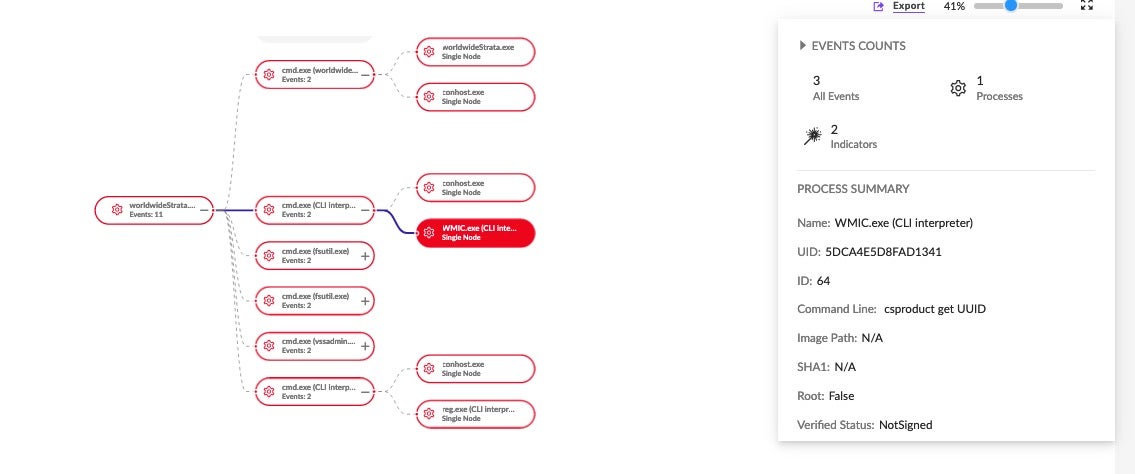
Post-Infection, Payment and Portal
Infected clients will be greeted with a ransom note as well as a modified desktop image.
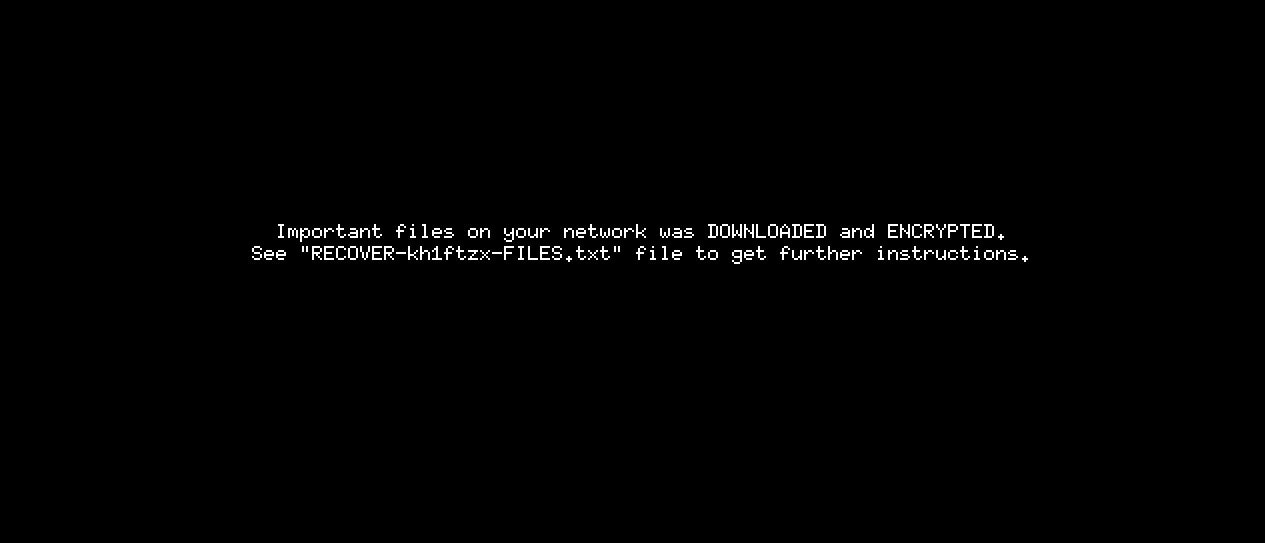
Infected uses are instructed to connect to the attackers’ payment portal via TOR.
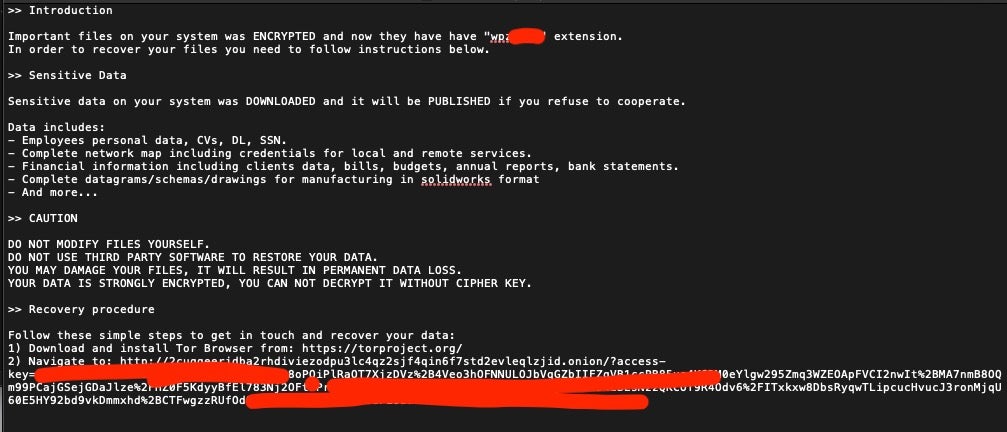
The ransom note informs the victim that not only have files been encrypted but data has been stolen.
Victim’s are threatened with data leakage if they refuse to pay and provided with a list of data types that have been stolen.


In theory, once victims connect to the attacker’s portal, they are able to communicate and potentially acquire a decryption tool. Everything on the BlackCat portal is tied back to the specific target ID, which must be supplied correctly from the URL in the ransom note.
Conclusion
In its relatively short time on the radar, BlackCat has carved a notable place for itself amongst mid-tier ransomware actors. This group knows their craft and are cautious when selecting partners or affiliates. It is possible that some of the increased affiliation and activity around BlackCat is attributed to other actors migrating to BlackCat as larger platforms fizzle out (Ryuk, Conti, LockBit and REvil).
Actors utilizing BlackCat know their targets well and make every attempt to stealthily compromise enterprises. Prevention by way of powerful, modern, endpoint security controls are a must. The SentinelOne Singularity Platform is capable of detecting and preventing BlackCat infections on both Windows and Linux endpoints.
Indicators of Compromise
SHA256
0c6f444c6940a3688ffc6f8b9d5774c032e3551ebbccb64e4280ae7fc1fac479
13828b390d5f58b002e808c2c4f02fdd920e236cc8015480fa33b6c1a9300e31
15b57c1b68cd6ce3c161042e0f3be9f32d78151fe95461eedc59a79fc222c7ed
1af1ca666e48afc933e2eda0ae1d6e88ebd23d27c54fd1d882161fd8c70b678e
28d7e6fe31dc00f82cb032ba29aad6429837ba5efb83c2ce4d31d565896e1169
2cf54942e8cf0ef6296deaa7975618dadff0c32535295d3f0d5f577552229ffc
38834b796ed025563774167716a477e9217d45e47def20facb027325f2a790d1
3d7cf20ca6476e14e0a026f9bdd8ff1f26995cdc5854c3adb41a6135ef11ba83
4e18f9293a6a72d5d42dad179b532407f45663098f959ea552ae43dbb9725cbf
59868f4b346bd401e067380cac69080709c86e06fae219bfb5bc17605a71ab3f
731adcf2d7fb61a8335e23dbee2436249e5d5753977ec465754c6b699e9bf161
74464797c5d2df81db2e06f86497b2127fda6766956f1b67b0dcea9570d8b683
7b2449bb8be1b37a9d580c2592a67a759a3116fe640041d0f36dc93ca3db4487
7e363b5f1ba373782261713fa99e8bbc35ddda97e48799c4eb28f17989da8d8e
bd337d4e83ab1c2cacb43e4569f977d188f1bb7c7a077026304bf186d49d4117
c3e5d4e62ae4eca2bfca22f8f3c8cbec12757f78107e91e85404611548e06e40
c8b3b67ea4d7625f8b37ba59eed5c9406b3ef04b7a19b97e5dd5dab1bd59f283
cefea76dfdbb48cfe1a3db2c8df34e898e29bec9b2c13e79ef40655c637833ae
f815f5d6c85bcbc1ec071dd39532a20f5ce910989552d980d1d4346f57b75f89
f8c08d00ff6e8c6adb1a93cd133b19302d0b651afd73ccb54e3b6ac6c60d99c6
SHA1
087497940a41d96e4e907b6dc92f75f4a38d861a
11203786b17bb3873d46acae32a898c8dac09850
2a53525eeb7b76b3d1bfe40ac349446f2add8784
45212fa4501ede5af428563f8043c4ae40faec76
57a6dfd2b021e5a4d4fe34a61bf3242ecee841b3
5869820f261f76eafa1ba00af582a9225d005c89
5c6ca5581a04955d8e4d1fa452621fbc922ecb7b
655c2567650d2c109fab443de4b737294994f1fd
783b2b053ef0345710cd2487e5184f29116e367c
89060eff6db13e7455fee151205e972260e9522a
9146a448463935b47e29155da74c68d16e0d7031
94f025f3be089252692d58e54e3e926e09634e40
a186c08d3d10885ebb129b1a0d8ea0da056fc362
c1187fe0eaddee995773d6c66bcb558536e9b62c
ce5540c0d2c54489737f3fefdbf72c889ac533a9
d65a131fb2bd6d80d69fe7415dc1d1fd89290394
da1e4a09a59565c5d62887e0e9a9f6f04a18b5f4
e17dc8062742878b0b5ced2145311929f6f77abd
e22436386688b5abe6780a462fd07cd12c3f3321
f466b4d686d1fa9fed064507639b9306b0d80bbf
MITRE ATT&CK
T1027.002 – Obfuscated Files or Information: Software Packing
T1027 – Obfuscated Files or Information
T1007 – System Service Discovery
T1059 – Command and Scripting Interpreter
TA0010 – Exfiltration
T1082 – System Information Discovery
T1490 – Inhibit System Recovery
T1485 – Data Destruction
T1078 – Valid Accounts
T1486 – Data Encrypted For Impact
T1140 – Encode/Decode Files or Information
T1202 – Indirect Command Execution
T1543.003 – Create or Modify System Process: Windows Service
T1550.002 – Use Alternate Authentication Material: Pass the Hash




